Original research |
Peer reviewed |
Influence of diet form (pellets or meal) on the optimal number of weaned pigs per feeding space
Martine Laitat, DVM; Marc Vandenheede, DVM, PhD; Alain Désiron, DVM; Bernard Canart, IE; Baudouin Nicks, DVM, PhD
ML: University of Liège, Faculty of Veterinary Medicine, Department of Clinical Sciences, Liège, Belgium. MV, AD, BC, BN: University of Liège, Faculty of Veterinary Medicine, Department of Animal Production, Liège, Belgium. Corresponding author: Dr M. Laitat, University of Liège, Faculty of Veterinary Medicine, Department of Clinical Sciences, Boulevard de Colonster B42, 20, 4000 Liège, Belgium; Tel: 32 (0)4 366 40 63; Fax: 32 (0)4 366 41 22; E-mail: mlaitat@ulg.ac.be.
Cite as: Laitat M, Vandenheede M, Désiron A, et al. Influence of diet form (pellets or meal) on the optimal number of weaned pigs per feeding space. J Swine Health Prod. 2004;12(6):288-295.
Also available as a PDF.
Summary
Objectives: To assess the influence of group size and diet form on performance and feeding behavior of weaned pigs and to determine an optimal number of pigs per feeding space for pellets or meal provided in a tube feeder.
Methods: During six consecutive trials, feeding behavior and performance of groups comprising 30 (G30), 40 (G40), or 50 (G50) weaned pigs were compared for 6 weeks after weaning. A tube feeder was used for all groups, delivering either pellets or meal (trough length 64 cm; two integrated drinkers).
Results: Mean ADG was 5% higher when pigs were fed pellets rather than meal (P = .06). Whatever the diet, ADG was lower in G50 than in G40 (P < .05). In groups fed meal, ADG was lower in G40 than in G30 (P < .001).
Average time using the feeder was 4.7 minutes per hour for pigs fed pellets, and 7.3 minutes per hour for pigs fed meal (P = .003). Overall feeder occupation rates during the day were 139 +/- 30% for meal and 93 +/- 21% for pellets (P = .01), and during the night, 91 +/- 33% for meal and 54 +/- 15% for pellets (P = .03), assuming 100% is four pigs eating simultaneously during the observation period.
Implications: Diet form influences the optimal number of pigs per feeder space. For the tube feeders in this study, the recommended maximum number of pigs per feeding space is 6.5 for pigs fed meal and 10.2 for pigs fed pellets.
Keywords: swine, feeding
space, diet
form, weaned pigs, feeding behavior
Search the AASV web site
for pages with similar keywords.
Received: February
17, 2003
Accepted: October
15, 2003
Housing design for farm animals is increasingly directed by laws aimed at ensuring that minimal conditions are met related to animal welfare. Combining high zootechnical performance and welfare requirements is thus now considered an important challenge for scientists, especially under the intensive breeding conditions of modern swine production.1-4
Legislation imposing minimum standards for protection of intensively housed pigs provides recommendations to avoid overcrowding. Overcrowding not only impairs welfare (eg, it may be associated with behaviors such as fighting and tail biting), but also has a negative effect on performance. Factors such as floor space allowance, animal density (ie, number of pigs per pen), and feeder space allowance are used to determine overcrowding. In finisher pigs, reducing floor space allowance from 1.64 m2 to 0.82 m2 per pig5 or from 0.74 m2 to 0.56 m2 per pig6 was associated with a lower ADG. In growing pigs weighing 15.9 kg to 41.5 kg, reducing space from 0.66 m2 to 0.33 m2 per pig tended to be associated with a lower ADG.5 Similarly, weaned pigs provided with 0.14 m2 per pig rather than 0.28 m2 per pig grew more slowly.7
Crowding is not only characterized by the number of pigs allocated per square meter, but is also influenced by group size. In finisher pigs, increasing the group size from five to 20 animals5 or from 10 to 40 animals,6 while providing the same floor space allowance per pig, had no significant effect on ADG. However, conflicting results were reported for weaned pigs. Performance was poorer when weaned pigs weighing 5.9 kg to 34.2 kg were housed 50 or 100 per pen rather than 25 per pen.8
The number of available feeding spaces in a pen may also contribute to overcrowding and thus may be associated with poorer performance. The effects on performance were studied in finisher pigs when the number of pigs per feeding space and the diet form (pellets or meal) were varied.9 For pigs fed meal ad libitum, ADG was lower during the growth period, but not during the finishing period, when there were either 20 or 10 pigs per feeding space rather than three per feeding space. For pigs fed pellets, there was no significant difference in ADG whatever the number of pigs (three, 10, or 20) per feeder space. Official recommendations about number of pigs per feeder space are not always clearly defined10,11 or do not distinguish between different types of diets (pellets or meal).12 The Swiss Federal Veterinary Office has published guidelines concerning the use of tube feeders for weaned pigs, based on a study13 recommending fewer than 60 pigs per tube feeder when fed ad libitum.
In the present study, performance and feeding behavior of 480 weaned pigs were compared according to group size (30, 40, or 50) when either pellets or meal were fed in a tube feeder. The objectives of the study were to assess the influence of group size and diet form (pellets or meal) on performance and feeding behavior of weaned pigs and to determine an optimal number of pigs per feeding space according to the diet form.
Materials and methods
Animals
Twelve groups of newly weaned pigs (weaned at 3 to 4 weeks of age) were used in six consecutive trials (N = 480), with the same numbers of females and castrated males in each group. These groups differed by the number of pigs per group (30, 40, or 50 in groups G30, G40, and G50, respectively) and by the diet form (pellets or meal). Each treatment was replicated twice for a total of six trials (Figure 1). All pigs originated from the same herd, which produced crossbred piglets from Large White x Landrace sows and Piétrain boars.
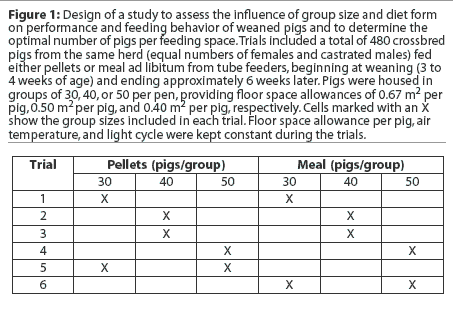
Housing conditions
Pigs were housed in two separate, adjacent experimental rooms, each 32 m2 and 106 m3, comprising a 20-m2 area deeply bedded with sawdust and a 12-m2 unbedded area with a solid floor. Floor space allowance was kept constant during the trials, providing 0.67 m2 per pig in G30, 0.50 m2 per pig in G40, and 0.40 m2 per pig in G50. Space allowance was not adjusted for mortality.
Air temperature was kept constant and similar during the six trials. Average air temperature was 23.6 +/- 0.5°C (automatic collection of data, one measurement per hour). Light cycle was on average 7:00 am to 7:00 pm.
Food and water delivery systems
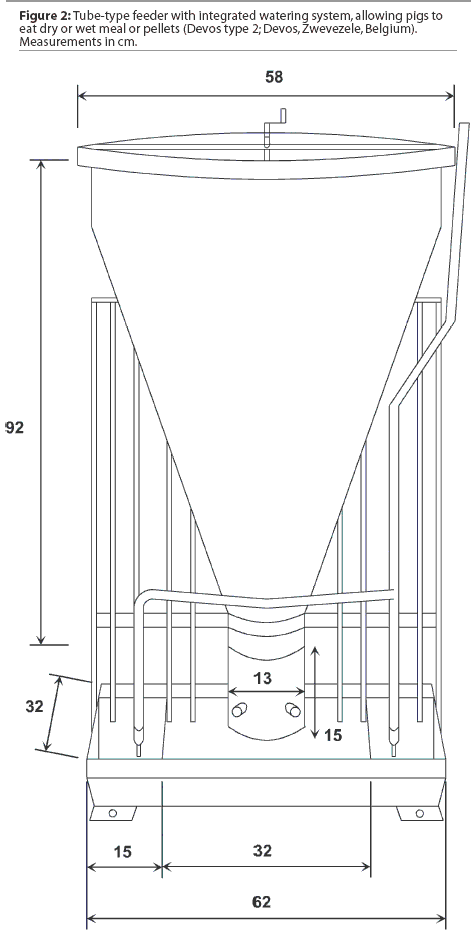 Feeding
behavior and performance data were collected for pigs, fed either 2.5-mm diameter
pellets or meal and provided with one feeder per pen. Meal and pellets
were of the same formulation, containing 18% crude protein, and were available
ad libitum from a tube-type feeder (Devos, type 2; Devos, Ruddervoordestraat,
Zwevezele, Belgium) with an integrated watering
system and a stainless steel feeding platform (Figure 2). The 32-cm long platform
was accessible from both sides, providing a total feeding length of 64 cm.
According
to Baxter,14 the width (l) in cm between
the shoulders of a pig can be estimated from the weight (W) in kg using the equation:
l = 6.1W0.33. For a pig of 16.5 kg
(average of initial and final mean weights of all
pigs used in the six trials), this width was 15.4 cm, and four pigs on average
could thus use one feeder simultaneously. At the beginning and at the end of
the
6-week postweaning period, 5.3 +/- 0.0 and 3.6 +/- 0.1 pigs, respectively, could
eat
simultaneously.
Feeding
behavior and performance data were collected for pigs, fed either 2.5-mm diameter
pellets or meal and provided with one feeder per pen. Meal and pellets
were of the same formulation, containing 18% crude protein, and were available
ad libitum from a tube-type feeder (Devos, type 2; Devos, Ruddervoordestraat,
Zwevezele, Belgium) with an integrated watering
system and a stainless steel feeding platform (Figure 2). The 32-cm long platform
was accessible from both sides, providing a total feeding length of 64 cm.
According
to Baxter,14 the width (l) in cm between
the shoulders of a pig can be estimated from the weight (W) in kg using the equation:
l = 6.1W0.33. For a pig of 16.5 kg
(average of initial and final mean weights of all
pigs used in the six trials), this width was 15.4 cm, and four pigs on average
could thus use one feeder simultaneously. At the beginning and at the end of
the
6-week postweaning period, 5.3 +/- 0.0 and 3.6 +/- 0.1 pigs, respectively, could
eat
simultaneously.
The Devos feeder consists of a funnel-shaped hopper suspended above a trough, with a water nipple on each side of the hopper. Two movable metal rods, extending from a metal agitator ring fitted around the lower extremity of the hopper, release feed when pigs push with their noses on four smaller rods on the four poles of the agitator ring. The trough is 8 cm lower beneath the water nipples than directly under the hopper, allowing pigs to eat wet feed under the water nipples or dry feed in the central part of the trough. The space between the bottom of the feed delivery tube and the trough can be adjusted by a crank handle, controlling the flow of feed.
No additional source of water was available. Drinkers were adjusted to a flow rate of 0.50 L to 0.80 L per minute in order to avoid water spillage; flow rate was checked once per trial. Each pen was equipped with one water meter.
Performance and feeding behavior
Pigs were individually weighed at weaning (Day 0) and at the end of the trial, a mean of 44 +/- 4 days later. These weights were used to calculate ADG. Water intake of each group of pigs was recorded daily. Food was stored in 25-kg bags and the hoppers were filled by hand. At the end of each trial, apparent food intake (including spillage) was used to calculate the mean feed:gain ratio for each pen.
During the six trials, between Days 7 and 36, pigs using the feeders were videotaped for 24-hour periods, on four occasions in Trials 5 and 6 and on five occasions in Trials 1 through 4, with a mean interval of 7 days between videotaping sessions. When darkness came, feeders were discreetly lighted by a 20W halogen lamp to allow nocturnal observations. A time-lapse recorder (Time Lapse Video Cassette Recorder AG-6040; Panasonic, Osaka, Japan) was used so that 24 hours of observations could be recorded on a 3-hour videotape.
Videotapes were used to make group observations. First, the number of pigs interacting with the feeder was noted by instantaneous sampling at 10-minute intervals, providing an estimate of the mean number of pigs using the feeder (N). Second, occupation time (OT), expressed as a percentage of observation time, was calculated as the period of time when at least one pig interacted with the feeder, determined on the basis of 1 minute per minute observations (1440 measurements per 24 h; one-zero sampling).15 Mean hourly time spent per pig at the feeder (T; minutes per hour) was calculated using the equation T = (N x 60 x OT) group size (for group sizes of 30, 40, or 50).
Mean daily feed intake was calculated as the total amount of feed added to the hopper in a pen divided by the number of days in the trial, divided by the number of pigs in the pen. Ingestion speed was estimated by dividing the mean daily feed intake by the mean daily time spent by each pig at the feeder.
An estimate of occupation rate (OR) for the feeders was obtained by the equation OR = (OT x N) n (where n is the theoretical number of feeding spaces). The duration of feeder overcrowding was defined as the amount of time when the mean occupation rate was higher than 100%.
To compare diurnal and nocturnal feeding activities, the 24-hour period was divided into day (7:00 am to 7:00 pm) and night (7:00 pm to 7:00 am). The optimal number of pigs per feeding space was calculated, taking into consideration the following welfare constraints: the well-known diurnal feeding preference of pigs;16 the need to avoid overcrowding (mean 24-hour OR < 100%); and maximal diurnal occupation rate of the feeder = 100% (ie, for 720 minutes). The optimal number of pigs per feeding space (X) was thus calculated by the equation X = 720 (DP x 24 x T), where DP is the proportion of time spent at the feeder during the diurnal period (when 24-hour OR < 100%).
Statistical analysis
Comparisons of ADG were made using one-way analysis of covariance, adjusting results for mean initial weights (GLM procedure, Statistical Analysis System, Release 8.2, SAS Institute Inc, Cary, North Carolina). Results were compared so that the effects of group size (30, 40, or 50 pigs) and diet form (pellets or meal) could be assessed. As only two values per treatment were available for the whole test period, daily feed intake and food conversion ratio were not tested. Daily water intake was compared using the least squares means method of the Mixed procedure allowing mixed models with repeated data (Mixed procedure, SAS), so that the effects of group size (30, 40, or 50 pigs) and diet form (pellets or meal) could be assessed.
Behavioral data, including OT, N, T, and OR, were compared using the least squares means method of the Mixed procedure allowing mixed models with repeated data (Mixed procedure, SAS) so that the effects of group size (30, 40, or 50 pigs), period of the day (day or night), and diet presentation (pellets or meal) could be assessed. No interaction term was included in the model. The level of significance was set at P = .05. The effect of time (ie, age of the animals) was tested using order-two polynomial regressions (REG procedure, SAS): order-two polynomial regressions of the mean time spent at the feeder (T, minutes per hour per pig) according to the number of weeks after weaning (S) were expressed as T = a + b S + c S2.
Results
Performance
Performance data are presented in Table 1. Overall (n = 473), the ADG of pigs fed pellets (409 +/- 80 g per day) was 5% higher than that of pigs fed meal (389 +/- 83 g per day) (P = .06). The difference in performance between pigs fed pellets or meal was not significant in G30 (P = .15), but in G40, ADG was 9% higher in pigs fed pellets than in pigs fed meal (Table 1; P < .01), and in G50, ADG was 8% higher in pigs fed pellets than in pigs fed meal (Table 1; P = .02). Whatever the diet, mean ADG was lower in G50 than in G40 (Table 1): ADG was 8% lower for G50 pigs than for G40 pigs fed pellets and ADG was 7% lower for G50 pigs than for G40 pigs fed meal. For pigs fed meal, ADG was 16% lower in G40 than in G30 (Table 1). Daily water intake did not differ, either when groups fed pellets and groups fed meal were compared, or when groups of different sizes (30, 40, or 50 pigs per pen) were compared.
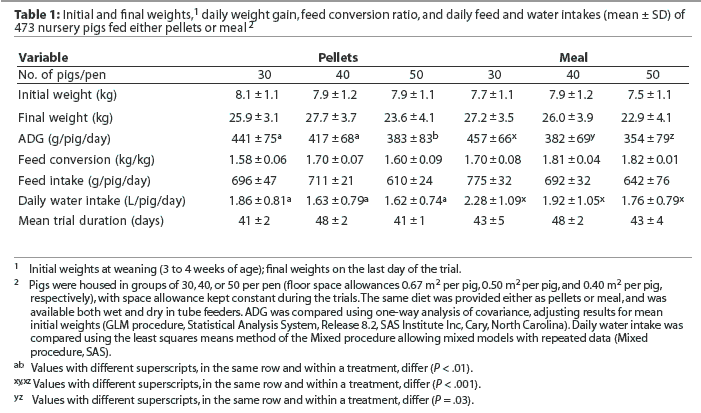
A total of seven pigs from six different groups either died (five pigs) or were removed from the study because of disease (two pigs).
Behavior
Occupation time was different for feeders delivering pellets and those delivering meal (Table 2), primarily because of the higher nocturnal activity of pigs eating meal. When meal was fed in G50, the feeder was occupied during > 11 nocturnal hours. When there were 50 pigs per pen, the occupation time for the feeder delivering pellets was 29% higher than when there were 30 pigs per pen (Table 2; P = .03). The occupation times in the different groups were not significantly different for the feeders delivering meal. The differences between occupation times for day and night were always significant when pigs were fed pellets (P < .05), but not when pigs were fed meal.
The difference between the numbers of pigs using the pellet-feeder and those using the meal-feeder was significant during the whole 24-hour period, and particularly between 7:00 am and 7:00 pm (P < .01). On average for the whole 24-hour period, one more pig used the pellet-feeder in G50 than in G30 (Table 2). There was also a difference of one pig using the meal-feeder between G30 and G40, and, in G50, about six pigs used the meal-feeder simultaneously. The number of pigs using the feeders was very similar in G50 eating pellets and in G30 eating meal, ie, about five pigs on average during the day and four during the night (Table 2). Approximately four pigs in G40 eating meal also used the feeder during the night, but in G50 eating meal, approximately five pigs on average used the feeder during the night (Table 2). During the day, six pigs used the meal-feeder in G40 and seven in G50 (Table 2).
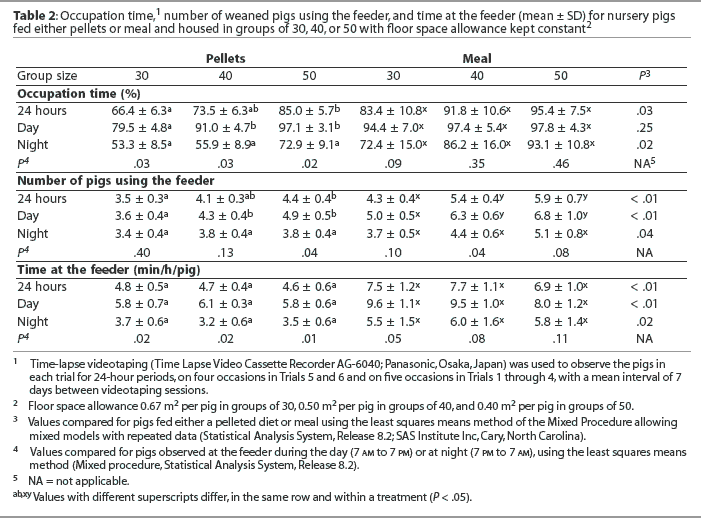
When they were fed pellets, pigs spent on average 4.7 minutes per hour (112.8 minutes per day) at the feeder, while pigs fed meal spent on average 7.3 minutes per hour (175.2 minutes per day; P < .01). The mean time spent at the feeder did not differ between group sizes, whatever the food presentation and the period of the day (P > .05). Whether they were fed pellets or meal, the pigs spent less time at the feeder during the night than during the day, and although the difference between day and night feeding times approached statistical significance for pigs fed meal, the difference was significant only for pigs fed pellets (P < .05).
As shown in Figure 3, order-2 polynomial regressions of the mean time spent at the feeder according to the number of weeks after weaning were significant both when pigs were fed meal and when they were fed pellets.
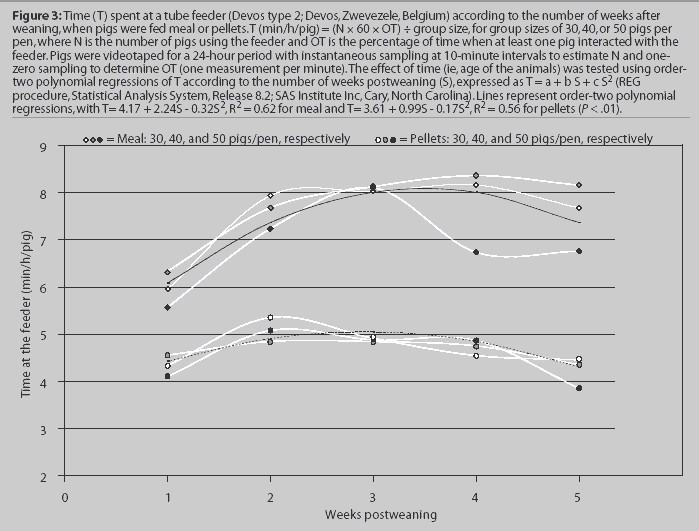
The estimates of ingestion speeds were 6.2, 6.3, and 5.5 g of pellets per minute and 4.3, 3.7, and 3.9 g of meal per minute when pigs were housed in groups of 30, 40, and 50 per pen, respectively.
Figure 4 shows the mean occupation rates for the feeder during the day and night for groups of 30, 40, and 50 pigs per pen fed either pellets or meal. An OR of 100% corresponds to four pigs eating simultaneously during the observation period. The overall mean occupation rates were 139 +/- 30% for the meal feeders and 93 +/- 21% for the pellet feeders during the day (P = .01) and 91 +/- 33% for the meal feeders and 54 +/- 15% for the pellet feeders during the night (P = .03). The proportion of the 24-hour period when the feeder was overcrowded (ie, OR > 100%) was relatively low for pigs fed pellets and housed in groups of 30 (5% of 24 hours) and 40 (23% of 24 hours). However, in groups of 50 fed pellets and in groups of 30 fed meal, overcrowding was observed during nearly 40% of 24 hours. The proportion of the 24-hour period when the feeder was overcrowded was 65% for groups of 40 fed meal and 77% for groups of 50 fed meal. In groups of 50 fed meal, the worst situation was observed during the fourth week after weaning, when the feeder was overcrowded for an average of 23.5 hours of the 24-hour period (ie, 98% of 24 hours), and the mean occupation rates were 182% during the day and 132% during the night.
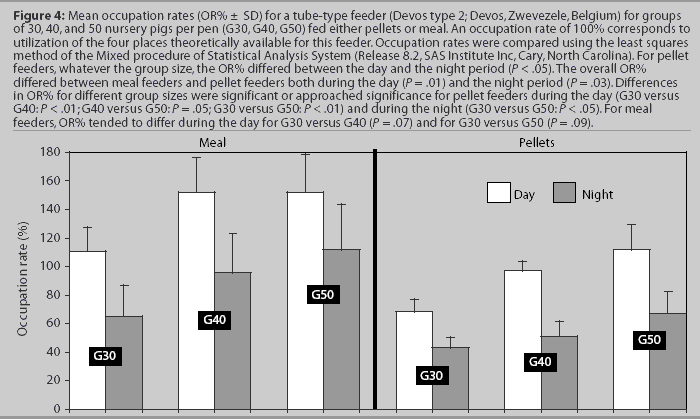
In groups of 30, 40, or 50 pigs fed pellets and in groups of 30 fed meal, where overcrowding did not occur (ie, mean 24-hour OR < 100%), approximately 63% of the time pigs spent at the feeder was observed between 7 am and 7 pm. The recommended number of pigs per feeding space (X) was determined from this value to be 6.5 pigs per feeder space when meal is fed, and 10.2 pigs per feeder space when pellets are fed.
Discussion
It is already known that floor space allowance may influence performance in weaned,7 growing,5 and finisher pigs.5,6 In those studies, the floor space allowance associated with poorer results was lower than that recommended for pigs at final weight,5 or was close to that recommended for pigs at initial weight.6,7 Moreover, it was hypothesized that, as group size increases, it may be possible to reduce the total amount of "free space" without having a negative effect on performance.6 Reducing space allowance from 0.74 m2 to 0.65 m2 had no negative impact when 20 finisher pigs were housed per pen on a slatted floor.6 In the present study, the same pen design was used for the 12 groups of pigs, ie, the pen included a deeply bedded, 20-m2 area. The floor space allowance per pig was thus 0.4 m2 per pig in G50, 0.5 m2 per pig in G40, and approximately 0.7 m2 per pig in G30. These values are in the range of, or higher than, the usual recommendations for 27-kg pigs,10,16,17 ie, 0.3 m2 and 0.4 m2, with 0.4 m2 being the space needed for full recumbency.17 The floor space allowance per pig was thus at least equal to the recommended values for pigs at final weight. Although these values met or exceeded commonly accepted standards for floor space allowance, differences according to group size must be interpreted cautiously.
The ADG of pigs in the present study revealed two essential facts. First, growth performance values decreased as group size increased, whatever the diet. However, the difference in ADG between G30 and G40 was significant only when pigs were fed meal. Second, results obtained with pellets were better than those obtained with meal only when there were 40 or 50 pigs per pen. Group size and food presentation are thus important parameters to take into account when managing performance.
Pigs are known to prefer diurnal feeding.18-23 This preference was not evident when pigs were housed 50 per pen and given meal in a tube-type feeder. Day and night feeder occupation times were not significantly different, and, in addition, the mean number of pigs using the feeder during the night was higher than the theoretical four feeder spaces, ie, the feeders were overcrowded.
Our results show that the time spent at the feeder by each pig was 1.6 times greater when they were fed meal rather than pellets, and this parameter was not influenced by group size. Thus, diet form had a distinct effect on feeding time in weaned pigs. Similar conclusions may be found in the literature for pigs at other stages of growth. Grower-finisher pigs fed meal in dry feeders spent 1.2 times longer eating than pigs using wet-dry feeders.24 Similarly, the time spent at the feeder per day by finisher pigs fed dry meal was 1.8 times longer than the time spent by finishers fed dry pellets.25
Rates of food consumption in this study are similar to previously reported values observed with trough feeders.26,27 In other circumstances, for example, in pregnant sows, there was an advantage to feeding mash instead of pellets because of the longer time spent eating and the associated shorter time spent performing stereotypic behaviour during the postfeeding period.28 In finisher pigs, Gonyou and Lou24 noted that the slower ingestion speed for meal compared to pellets is likely to reduce the number of pigs that can be fed from a feeding space, because the total eating time is longer. The results of the present study suggest that this is also true for weaned pigs fed from a tube-type feeder.
To avoid overcrowding at the feeder, which may impair welfare and performance, our recommendations are not to exceed one feeding space for 10.2 piglets fed pellets and for 6.5 piglets fed meal, corresponding to 41 and 26 pigs per feeder, respectively, for feeders with four feeding spaces. A recent study13 in pigs fed pellets (A. Kircher, written communication) in a similar tube-type feeder also indicated that maintaining a ratio of 10 animals per feeding space is critical. However, the authors included drinking spaces in this ratio, thus providing six available feeding spaces per feeder and not four as in the present study. To calculate the maximum number of pigs per feeder, the number of effective available feeding spaces thus must be defined for "communal-rectangular" troughs.29
Implications
- Diet form is an important parameter to consider when determining the optimal number of pigs per feeding space.
- For tube-type feeders, the optimal ratio of nursery pigs to feeding spaces is 10.2:1 for pellets and 6.5:1 for meal.
Acknowledgments
The authors thank T. Pluymers and Ch. Remy for their technical assistance and J.-P. Cullus and M. Bodson for care of the animals. Many thanks to F. Farnir, J. Detilleux, A. Felix, and J.-M. Beduin for their time and advice on statistical analysis and also to V. de Behr for her valuable help.
References
1. Nielsen BL, Lawrence AB, Whittemore CT. Effect of group size on feeding behaviour, social behaviour and performance of growing pigs using single-space feeders. Livest Prod Sci. 1995;44:73-85.
2. Spoolder HAM, Edwards SA, Corning S. Effects of group size and feeder space allowance on welfare in finishing pigs. Anim Sci. 1999;69:481-489.
3. Turner SP, Edwards SA, Bland VC. The influence of drinker allocation and group size on the drinking behaviour, welfare and production of growing pigs. Anim Sci. 1999;68:617-624.
*4. Korthals RL. Evaluation of space requirements for swine finishing feeders. Trans Am Soc Agric Eng. 2000;43:395-398.
5. Randolph JH, Cromwell GL, Stahly TS, Kratzer DD. Effects of group size and space allowance on performance and behaviour of swine. J Anim Sci. 1981;53:922-927.
6. McGlone JJ, Newby BE. Space requirements for finishing pigs in confinement: behavior and performance while group size and space vary. Appl Anim Behav Sci. 1994;39:331-338.
7. Kornegay ET, Meldrum JB, Chickering WR. Influence of floor space allowance and dietary selenium and zinc on growth performance, clinical pathology measurements and liver enzymes, and adrenal weights of weanling pigs. J Anim Sci. 1993;71:3185-3198.
8. Wolter BF, Ellis M, Curtis SE, Augspurger NR, Hamilton DN, Parr EN, Webel DM. Effect of group size on pig performance in a wean-to-finish production system. J Anim Sci. 2001;79:1067-1073.
9. Albar J, Granier R. L'alimentation au nourrisseur: incidence du nombre de porcs par place sur les performances d'engraissement [Feeding at the feeder: influence of the number of pigs per space on performance of finishers]. Journées de la Recherche Porcine en France. 1989;21:309-316.
10. Recommended code of practice for the care and handling of farm animals: Pigs. Agriculture and Agri-Food Canada Publication. 1993. Publication 1898/E.
11. Commission Directive 2001/93/EC of 9 November 2001 amending Directive 91/630/EEC laying down minimum standards for the protection of pigs. Official Journal L 316, 01/12/2001:0036-0038. Available at http://europa.eu.int/eur-lex/index.html. Accessed September 1, 2004.
12. Bundesgesetzblatt (Bonn) [Federal Law Journal]. Teil I. Verordnung zum Schutz von Schweinen bei Stallhaltung (Schweinehaltungsverordnung) [Part 1. Rules for the protection of pigs in pig breeding]. 1994;9:312-315. Available at http://www.jura.uni-sb.de. Accessed September 3, 2004.
13. Kircher A, Weber R, Wechsler B, Jungbluth T. The effect of the animal/feeding place ratio on the behaviour and performance of weaned pigs fed at a tube feeder. Kuratorium für Technik und Bauwesen in der Landwirtscharft Schrift. 2000;403:120-127.
14. Baxter S. Intensive pig production: environmental management and design. London: Granada Publishing; 1984:317-344.
15. Martin PR, Bateson P. Measuring behaviour: An introductory guide. Cambridge: Cambridge University Press; 1986:48-69.
16. Council Directive 2001/88/CE of 23 October 2001 amending Directive 91/630/EEC laying down minimum standards for protection of pigs. Official Journal L316, 01/12/2001:0001-0004. Available at http://europa.eu.int/eur-lex/index.html. Accessed September 1, 2004.
17. Petherick JC. A biological basis for the design of space in livestock housing. In: Baxter SH, Baxter MR, MacCormack JAC, eds. Farm Animal Housing and Welfare. The Netherlands: Martinus Nijhoff Publishers; 1983:103-120.
18. Auffray P, Marcilloux JC. Analysis of porcine feeding patterns from weaning to adulthood. Reproduction, Nutrition, Développement. 1980;20:1625-1632.
19. Auffray P, Marcilloux JC. An analysis of feeding patterns in the adult pig. Reproduction, Nutrition, Développement. 1983;23:517-524.
20. Feddes, JJR, Young BA, DeShazer JA. Influence of temperature and light on feeding behaviour of pigs. Appl Anim Behav Sci. 1989;23:215-222.
21. Labroue F, Guéblez R, Meunier-Salaün M-C, Sellier P. Feed intake behaviour of group-housed Piétrain and Large White growing pigs. Annales de Zootechnie. 1999;48:247-261.
22. Massabie P, Quiniou N, Granier R. Influence of range of diurnal fluctuation of temperature on performance of growing pigs kept at an average ambient temperature of 24 degrees C. Journées de la Recherche Porcine en France. 1999;31:125-131.
23. Massabie P, Quiniou N. Influence of range of cycling temperature on the performance of growing pigs kept at an average ambient temperature of 20 or 28 degrees C. Journées de la Recherche Porcine en France. 2001;33:17-23.
24. Gonyou HW, Lou Z. Effects of eating space and availability of water in feeders on productivity and eating behavior of grower/finisher pigs. J Anim Sci. 2000;78:865-870.
*25. MacDonald KAM, Gonyou HW. To what extent can pigs adapt to a spatially restricted food source? Proc 35th Int Congress Int Soc Appl Ethology; 2001:89.
26. Ermer PM, Miller PS, Lewis AJ. Diet preference and meal patterns of weanling pigs offered diets containing either spray-dried porcine plasma or dried skim milk. J Anim Sci. 1994;32:1548-1554.
27. Bigelow JA, Houpt TR. Feeding and drinking patterns in young pigs. Physiol Behav. 1988;43:99-109.
28. Bergeron R, Meunier-Salaün MC, Robert S. Effects of food texture on meal duration and behaviour of sows fed high-fibre or concentrate diets. Can J Anim Sci. 2002;82:587-589.
29. O'Connell NE, Beattie VE, Weatherup RN. Influence of feeder type on the performance and behaviour of weaned pigs. Livest Prod Sci. 2002;74:13-17.
* Non-refereed references
